Team Everest Anniversary Post #2: Getting Around
Gene Rodgers
May 9, 2017
To commemorate the 14th anniversary of CTD's Team Everest '03 Expedition, trekker and long-time CTD member Gene Rodgers shares his memories of the event in a series of guest blog posts. Check in Tuesdays in May for new posts!
Everest by Doko
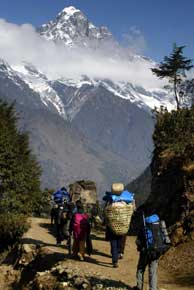 When terrain got unforgiving, the four wheelchairs users in Team Everest were transported in dokos, wicker baskets that Sherpa constructed to carry children or supplies (left). People often think of Sherpa as porters in the mountains. Actually, Sherpa is an ethnic term. All Sherpa come from the same part of Nepal.
When terrain got unforgiving, the four wheelchairs users in Team Everest were transported in dokos, wicker baskets that Sherpa constructed to carry children or supplies (left). People often think of Sherpa as porters in the mountains. Actually, Sherpa is an ethnic term. All Sherpa come from the same part of Nepal.
The Sherpa weave the basket shaped dokos with bamboo on the spot whenever they’re needed. Each doko is very lightweight and is carried on the backs of Sherpa with one strap resting on the forehead. That single strap supports the entire weight of the doko and its contents. It’s not uncommon for them to carry over 200 pounds. After each trip, the doko is usually disassembled and repurposed or discarded.
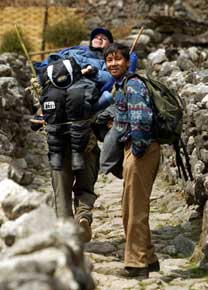 Though the Sherpa were strong and agile, this type of expedition was new for them and trekkers alike. We experimented with new ways of using dokos, but in the end, tradition won out. We got carried, as all supplies have been for hundreds of years over this mountainous terrain, on the backs of Sherpa (left: Gene in a doko).
Though the Sherpa were strong and agile, this type of expedition was new for them and trekkers alike. We experimented with new ways of using dokos, but in the end, tradition won out. We got carried, as all supplies have been for hundreds of years over this mountainous terrain, on the backs of Sherpa (left: Gene in a doko).
The Sherpa could carry loads twice their weight at high elevations where the air is thin. At one point, a Sherpa carried Barry, still in his wheelchair, on his back, a load of well over 240 pounds.
Carried by doko through a village, I might be 50 yards ahead of the Sherpa that was carrying my wheelchair. I wondered if the villagers knew we were disabled or thought we were lazy. If they had seen the wheelchairs, what did they think?
Traveling while disabled
Team Everest consisted of about 10 of us with disabilities, including four wheelchair users. We gathered at the Austin airport to begin our journey, but didn’t get to know each other until we reached our final destination of Kathmandu, Nepal. The 36-hour plane ride, including stops in L.A, Taipei, and Bangkok, was our first test of endurance. Just traveling by air exhausted everyone.
Travel also took a toll on our equipment. The first one to have problems was Mark, a paraplegic with spina bifida. He had rented his first off-road wheelchair specifically for this trek. It was a wobbly display of manly muscle chair that did everything, except work.
In L.A., Mark realized that a broken tendon in the front wheel was making him pop a wheelie in order to propel forward. After wasting a great deal of energy on moving forward on level ground, he hopped on a luggage carrier and was pushed around the airport like a suitcase.
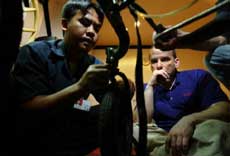
Mark was resourceful. He used his charisma and charm to engage maintenance staff at each airport. Many tried to help, but were out of their element. Mark handled each failed attempt with dignity. Rather than display his frustration, he maintained an optimistic demeanor with a smile. He always respected and thanked the folks that tried to help him by shaking their hands while looking them in the eyes.
At our stop in Bangkok, Mark summoned a non-English speaking aircraft mechanic who was able to devise ingenious ways to temporarily fix the problem (left). With admirable concentration and mechanical improvisation, he fashioned a makeshift metal brace that kept the front fork and wheel wedded together for several days. However, Mark knew it wouldn’t last for long.
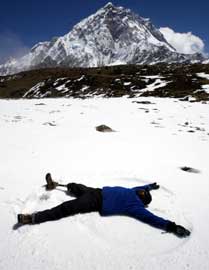
When we reached Kathmandu, Mark was determined to find a more permanent solution. He knew there was a solution somewhere, but had to accept that a replacement part couldn’t be replicated or conjured on this trek.
--
Mark wasn’t the only trekker using equipment new to him. Dinesh, a 26 year old web designer who lost a leg to cancer when he was a boy, had problems with a new prosthetic leg made especially for the trip. It was rigged for cold weather and rough terrain. While in the Austin airport, his day pack rubbed against a switch in the leg that controls the bend in the knee, and it sent him tumbling. Fortunately, he wasn’t hurt.
--
Regardless of what happened with any of our equipment though, the trek went on (as shown by Dinesh, right).
Read Post #3: Getting Acclimatized and Acquainted
Photos by Erich Schlegel, The Dallas Morning News.
About Gene
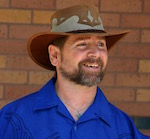 Adventurer, activist, media star, and educator Gene Rodgers earned a bachelors degree in Education, an MBA, and graduate and post-graduate studies in rehabilitation. He has traveled in 44 countries, on six continents, and a number of island nations. He has enjoyed recreational activities and adventure sports including skydiving, sailing, paragliding, scuba diving, and, of course, trekking in the Himalayas. To to share his experiences, Gene created the TV/Web show “The Gene And Dave Show” with Dave Dauber. View the award winning show on Access Austin or TheGeneAndDaveShow.com. Gene is a long-time member of CTD and ADAPT of Texas.
Adventurer, activist, media star, and educator Gene Rodgers earned a bachelors degree in Education, an MBA, and graduate and post-graduate studies in rehabilitation. He has traveled in 44 countries, on six continents, and a number of island nations. He has enjoyed recreational activities and adventure sports including skydiving, sailing, paragliding, scuba diving, and, of course, trekking in the Himalayas. To to share his experiences, Gene created the TV/Web show “The Gene And Dave Show” with Dave Dauber. View the award winning show on Access Austin or TheGeneAndDaveShow.com. Gene is a long-time member of CTD and ADAPT of Texas.


